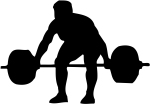Group: Strength & Powerlifting
Created: 2012/01/01,
Members: 39,
Messages: 16459
Discuss the topic of Power lifting, Strength training and Strong Man training!
Join groupDiscuss the topic of Power lifting, Strength training and Strong Man training!
Join group

Tinnuk
Posts:
291
Joined: 2005/12/19  |
2008/06/25, 04:23 PM
Right, so essentially everything I know on the topic so far is entirely from "Beyond Stretching", but, as usual, there's some things I'd like to clear up here.
1. Apparently if you can hold one leg up at a 90 degree angle, then you're capable of doing the splits since no muscles connect both legs. If this is the case, then having both legs out at that angle would not increase the magnitude of the stretch; it's my understanding that muscle spindles detect magnitude and velocity and are responsible for activating the stretch reflex. So why exactly does the stretch reflex fire when somebody who can hold one leg out attempts the splits? 2. Warm ups are downplayed in the book, but plyometric flexibility training (PFT) is advocated as preparation for speed-strength sports. Basically the principle is firing off the stretch reflex and taking advantage of residual recruitment and/or immediate recruitment (like in the squat). What I'm not understanding is that Pavel describes PFT as "sharpening" the stretch reflex, whereas relaxed stretching "flattens" or "dulls" the stretch reflex. I thought that "flattens" or "dulls" would refer to the desensitization of the stretch reflex, as in the general goal of flexibility training, but there's an apparent distinction. What does he mean by "sharpening" and "flattening"? If somebody already owns the book, they might be able to make sense of what I'm saying here. 3. I may already be aware, but what exactly is the difference between relaxed and active stretching? |
|
| |

wrestler125
Posts:
4,619
Joined: 2004/01/27  |
2008/06/27, 09:17 AM
1. While there are no muscles running from left to right leg, there are tendons. However, the stretch reflex is not physical, it is mental. Your body is trying to protect you from an area where you don't have the strength to be safe. That is why the most effective stretching (PNF) comes with strength increases in the stretched ROM. There is absolutely nothing physical about it.
If you ever have the good fortune of getting to play with cadavers, they are the most flexible people you'll ever meet. Their limbs can be moved freely, and there are no signs of scar tissue or knotting. Also, under anesthesia, people report remarkable flexibility that they otherwise would not be able to achieve. The simple reason is that the body is comfortable with having one leg up, but not 2. 2. I'm not sure about the terminology he is using, but when you statically stretch a muscle, it does deaden the muscle. This would also deaden the stretch reflex, but it also weakens the muscle not just in the stretched ROM but in a shorted ROM as well. As far as warm ups, while it is dependent, research (starting with soviet research) has shown improvements in performance accompanying a warm up, even a passive warm up. Being warm is rarely a bad thing (except in terms of hormonal output). 3 He may be referring to the difference between PNF and static or dynamic streching. PNF involves a contraction in the stretched position to tire the muscle, usually followed by relaxing the muscle and furthering the stretch. -------------- SQUAT MORE ~Jesse Marunde Blood Guts Sweat Chalk |

Tinnuk
Posts:
291
Joined: 2005/12/19  |
2008/07/01, 12:18 AM
4. Hypothetically, if one were to desensitize the stretch reflex "too much", would it be possible to recondition it to fire sooner again?
|

wrestler125
Posts:
4,619
Joined: 2004/01/27  |
2008/07/01, 08:43 AM
Yes. -------------- SQUAT MORE ~Jesse Marunde Blood Guts Sweat Chalk |

Tinnuk
Posts:
291
Joined: 2005/12/19  |
2008/07/01, 10:23 AM
Just by cutting back on the stretching I assume?
|

wrestler125
Posts:
4,619
Joined: 2004/01/27  |
2008/07/01, 10:41 AM
For the most part. Also, keeping the limb in a position that shortens the muscle for large amounts of time will generally cause this to happen. Reduced ROM exercise will also have the same effect.
Keep in mind though, that by increasing flexibility you are not necessarily reducing plyometric ability, ie jumping, etc. Just because someone is flexible doesn't mean they can't jump well. Most vertical leap programs will have some kind of stretching. The caveat is that stretching the hip flexors will almost always have an immediate and noticeable effect on vertical jump. -------------- SQUAT MORE ~Jesse Marunde Blood Guts Sweat Chalk |

Tinnuk
Posts:
291
Joined: 2005/12/19  |
2008/07/01, 10:56 AM
Given that dynamic and plyometric stretches teach fast loading, I'm pretty sure that they would heighten one's ability to jump and do explosive movements.
|
